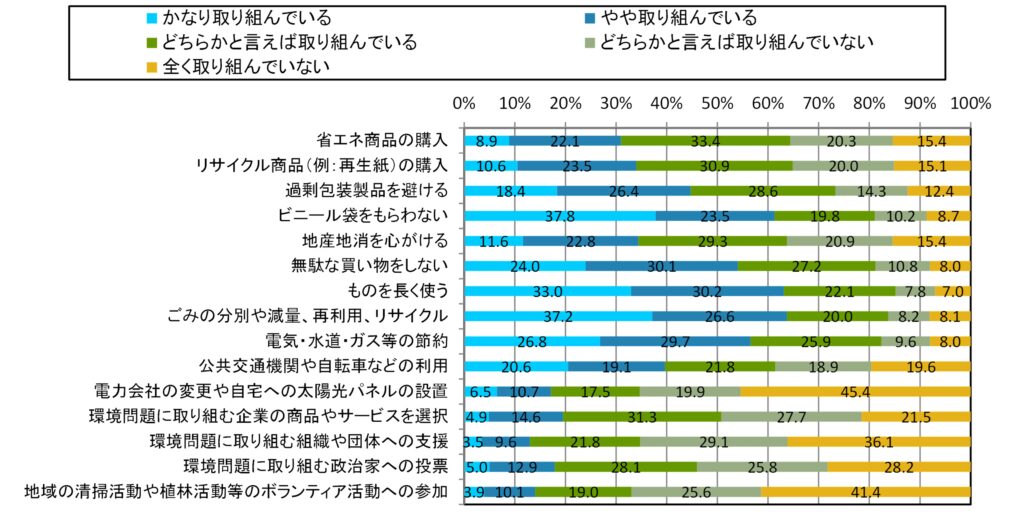
CONSUMER BEHAVIOUR
Here is one example of a sustainability analysis of consumer behavior that our laboratory is working on.
Analysis of the Consumer Value-Action Gap
Here is one example of a sustainability analysis of consumer behavior that our laboratory is working on.
Analysis of the Consumer Value-Action Gap
In recent years, consumers in Japan and around the world (especially in developed countries) have become increasingly aware of the importance of environmental protection. For example, according to a Eurobarometer survey, 94% of EU citizens feel that environmental protection is personally important to them, and 87% of them believe that their own actions play an important role in environmental protection. These results are consistent with our survey of 6,000 consumers in Japan in 2022, discussed below. The survey results show that many Japanese consumers have a high level of environmental awareness (see figure below).

The “value-action gap” refers to the gap between consumers’ awareness of environmental protection (i.e., values) and their implementation of environmental protection (i.e., actions). It has been noted in much of the literature that many consumers have this value-action gap. In fact, other Eurobarometer surveys show that even among EU citizens with high environmental awareness, only 35%, 27%, and 19% of them actually save energy and plastic, conserve water, and avoid excessive packaging, respectively. Our survey of Japanese consumers shows similar results (see figure below).

What factors contribute to this value-action gap? This is one of the research topics we are challenging. Specifically, our research team believes that one of the factors contributing to this gap is the lack of communication between producers and consumers, and we have turned to “eco-labels” as a potential tool to bridge the gap.
Eco-labels are one useful way for producers to communicate the environmental performance of their products to consumers. Although the environmental performance of a product or service is not visually apparent, by placing a label such as the ones shown in the figure below right on a product package, consumers can instantly understand that it is an environmentally friendly product. Many readers may have seen at least one or more of the labels listed in the figure


Although eco-labels are expected to close the value-action gap in consumer purchasing behavior, the question remains as to whether eco-labels are actually doing their role. Have you ever actually purchased a product taking this eco-label into account? Again to take an example from a survey conducted by Eurobarometer, less than 20% of the environmentally conscious EU citizens have purchased a labeled product in the past 6 months.
Given this fact, our research team conducted a survey of 6,000 Japanese consumers in 2022 on their environmental protection awareness and behavior, especially their use of eco-labels. Then, by applying an econometric model to the survey results, we identified the important determinants for consumers’ eco-label consideration.
First, the survey results showed that more than 70% of Japanese consumers are aware of eco-labels (see figure below left). Only less than 40% of them answered that they fully (or strongly) consider eco-labels on a daily basis (see lower right figure).

Furthermore, the application of an econometric model to the survey results revealed the factors that are important for consumers to consider eco-labels. Specifically, label trust, consumer environmental awareness, and consumer preferences were identified as the three most important factors for consumers to consider eco-labels. Label trust in particular is an important determinant, because, compared to the other factors, it could be improved by some initiative of the label operating agency.
For more information on the analysis, see the following paper:
Nakaishi, T., Chapman, A., (2023). Determinants of eco-label consideration: Towards a trusted labelling program. (Under review in J. Retail. Consum. Serv.).